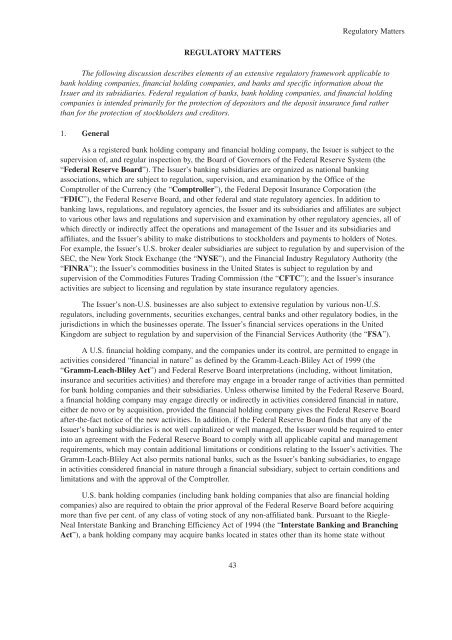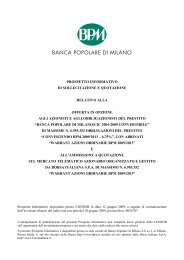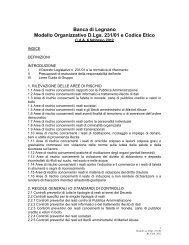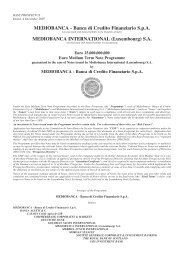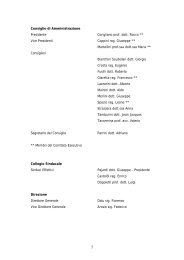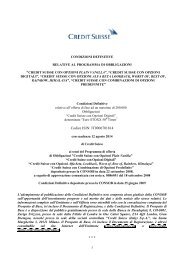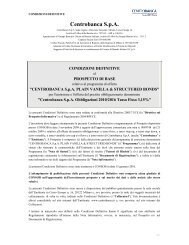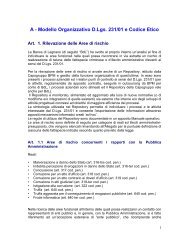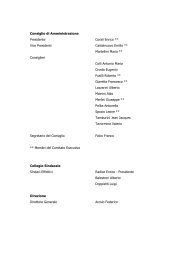INDEX OF DEFINED TERMS - Banca di Legnano
INDEX OF DEFINED TERMS - Banca di Legnano
INDEX OF DEFINED TERMS - Banca di Legnano
You also want an ePaper? Increase the reach of your titles
YUMPU automatically turns print PDFs into web optimized ePapers that Google loves.
Level: 2 – From: 2 – Wednesday, July 21, 2010 – 14:35 – eprint6 – 4247 Section 03<br />
Regulatory Matters<br />
REGULATORY MATTERS<br />
The following <strong>di</strong>scussion describes elements of an extensive regulatory framework applicable to<br />
bank hol<strong>di</strong>ng companies, financial hol<strong>di</strong>ng companies, and banks and specific information about the<br />
Issuer and its subsi<strong>di</strong>aries. Federal regulation of banks, bank hol<strong>di</strong>ng companies, and financial hol<strong>di</strong>ng<br />
companies is intended primarily for the protection of depositors and the deposit insurance fund rather<br />
than for the protection of stockholders and cre<strong>di</strong>tors.<br />
1. General<br />
As a registered bank hol<strong>di</strong>ng company and financial hol<strong>di</strong>ng company, the Issuer is subject to the<br />
supervision of, and regular inspection by, the Board of Governors of the Federal Reserve System (the<br />
“Federal Reserve Board”). The Issuer’s banking subsi<strong>di</strong>aries are organized as national banking<br />
associations, which are subject to regulation, supervision, and examination by the Office of the<br />
Comptroller of the Currency (the “Comptroller”), the Federal Deposit Insurance Corporation (the<br />
“FDIC”), the Federal Reserve Board, and other federal and state regulatory agencies. In ad<strong>di</strong>tion to<br />
banking laws, regulations, and regulatory agencies, the Issuer and its subsi<strong>di</strong>aries and affiliates are subject<br />
to various other laws and regulations and supervision and examination by other regulatory agencies, all of<br />
which <strong>di</strong>rectly or in<strong>di</strong>rectly affect the operations and management of the Issuer and its subsi<strong>di</strong>aries and<br />
affiliates, and the Issuer’s ability to make <strong>di</strong>stributions to stockholders and payments to holders of Notes.<br />
For example, the Issuer’s U.S. broker dealer subsi<strong>di</strong>aries are subject to regulation by and supervision of the<br />
SEC, the New York Stock Exchange (the “NYSE”), and the Financial Industry Regulatory Authority (the<br />
“FINRA”); the Issuer’s commo<strong>di</strong>ties business in the United States is subject to regulation by and<br />
supervision of the Commo<strong>di</strong>ties Futures Tra<strong>di</strong>ng Commission (the “CFTC”); and the Issuer’s insurance<br />
activities are subject to licensing and regulation by state insurance regulatory agencies.<br />
The Issuer’s non-U.S. businesses are also subject to extensive regulation by various non-U.S.<br />
regulators, inclu<strong>di</strong>ng governments, securities exchanges, central banks and other regulatory bo<strong>di</strong>es, in the<br />
juris<strong>di</strong>ctions in which the businesses operate. The Issuer’s financial services operations in the United<br />
Kingdom are subject to regulation by and supervision of the Financial Services Authority (the “FSA”).<br />
A U.S. financial hol<strong>di</strong>ng company, and the companies under its control, are permitted to engage in<br />
activities considered “financial in nature” as defined by the Gramm-Leach-Bliley Act of 1999 (the<br />
“Gramm-Leach-Bliley Act”) and Federal Reserve Board interpretations (inclu<strong>di</strong>ng, without limitation,<br />
insurance and securities activities) and therefore may engage in a broader range of activities than permitted<br />
for bank hol<strong>di</strong>ng companies and their subsi<strong>di</strong>aries. Unless otherwise limited by the Federal Reserve Board,<br />
a financial hol<strong>di</strong>ng company may engage <strong>di</strong>rectly or in<strong>di</strong>rectly in activities considered financial in nature,<br />
either de novo or by acquisition, provided the financial hol<strong>di</strong>ng company gives the Federal Reserve Board<br />
after-the-fact notice of the new activities. In ad<strong>di</strong>tion, if the Federal Reserve Board finds that any of the<br />
Issuer’s banking subsi<strong>di</strong>aries is not well capitalized or well managed, the Issuer would be required to enter<br />
into an agreement with the Federal Reserve Board to comply with all applicable capital and management<br />
requirements, which may contain ad<strong>di</strong>tional limitations or con<strong>di</strong>tions relating to the Issuer’s activities. The<br />
Gramm-Leach-Bliley Act also permits national banks, such as the Issuer’s banking subsi<strong>di</strong>aries, to engage<br />
in activities considered financial in nature through a financial subsi<strong>di</strong>ary, subject to certain con<strong>di</strong>tions and<br />
limitations and with the approval of the Comptroller.<br />
U.S. bank hol<strong>di</strong>ng companies (inclu<strong>di</strong>ng bank hol<strong>di</strong>ng companies that also are financial hol<strong>di</strong>ng<br />
companies) also are required to obtain the prior approval of the Federal Reserve Board before acquiring<br />
more than five per cent. of any class of voting stock of any non-affiliated bank. Pursuant to the Riegle-<br />
Neal Interstate Banking and Branching Efficiency Act of 1994 (the “Interstate Banking and Branching<br />
Act”), a bank hol<strong>di</strong>ng company may acquire banks located in states other than its home state without<br />
43


